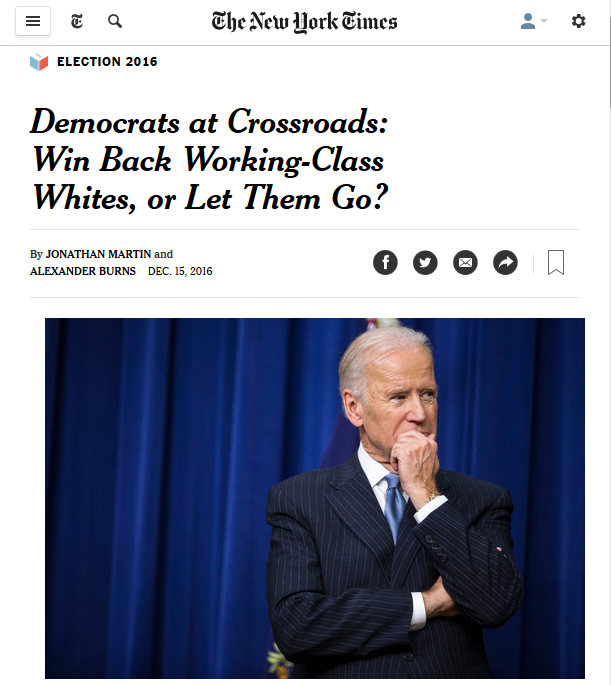The New York Times piece “Democrats at Crossroads: Win Back Working-Class Whites, or Let Them Go?” (12/15/16) by Jonathan Martin and Alexander Burns, is worth unpacking a bit. It sums up a “heated debate” the Democrats are having:
Should the party continue tailoring its message to the fast-growing young and nonwhite constituencies that propelled President Obama, or make a more concerted effort to win over the white voters who have drifted away?
So what are the two sides of this debate heatedly suggesting we do? On the one hand, we have Democrats who say the party has to focus on “winning back white voters of modest means.” How do you do that? “Focusing more on rural America,” says Agriculture Secretary Tom Vilsack. “Be more open to pursuing moderate and conservative voters,” suggests Rep. Gwen Graham (D.-Fla.). Not “ceding too much territory to Republicans in whiter, more conservative areas,” say “some Democrats”—exemplified by Labor Secretary Thomas Perez, who notes that “we got our ass kicked in a lot of these rural pockets.”
Vice President Joe Biden is said to be in camp that wants Democrats to do more “to reach white working-class voters,” telling CNN (12/11/16): “I mean, these are good people, man! These aren’t racists. These aren’t sexists.”
On the other hand, you have Democrats who argue that “the party must tailor a platform and strategy that explicitly appealed to younger and nonwhite voters on issues like policing, climate change and immigration.” Pollster Cornell Belcher says “this mythical unicorn white swing voter” is “a shrinking, increasingly resistant market.” “Demographically, the Electoral College is heading in the right direction,” insists former Obama adviser Dan Pfeiffer.
So a strategy that goes after rural, whiter, more conservative voters—presumably by being more conservative—vs. a strategy of counting on demographics to deliver victory to a party focused on social and environmental issues.
What’s lacking here is any discussion of economic issues—which is because the Democratic insiders the New York Times relies on for its insights don’t want to talk about economic issues. The “liberal” side in this argument is the side that still believes in the fantasy that was summed up by Michael Lind in the pages of the New York Times (4/16/16; FAIR.org, 4/26/16):
The Clintonian synthesis of pro-business, finance-friendly economics with social and racial liberalism no longer needs to be diluted, as it was in the 1990s, by opportunistic appeals to working-class white voters.
On the other side are those who do want to make “opportunistic” appeals to working-class whites—not by offering economic policies that would benefit the working class at the expense of the rich, mind you, but by toning down the Democrats’ anti-racism and pro-environmentalism (identified as “identity politics“), and playing to the prejudices of “rural” conservatives with some kind of Trump Lite.
That’s the debate the New York Times offers on the Democrats’ future. What if you want to appeal to working-class voters of all races with populist economic appeals, without treating the rights of people of color, immigrants and the LGBTQ as chits to be traded away? You’re not part of the conversation.
Jim Naureckas is the editor of FAIR.org. You can find him on Twitter at @JNaureckas.
You can send a message to the New York Times at letters@nytimes.com, or write to public editor Liz Spayd at public@nytimes.com (Twitter:@NYTimes or @SpaydL). Please remember that respectful communication is the most effective.

